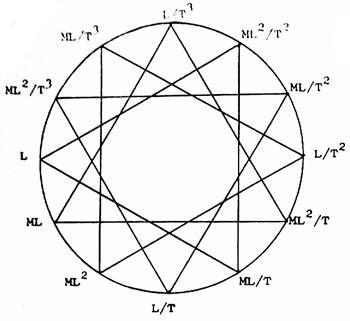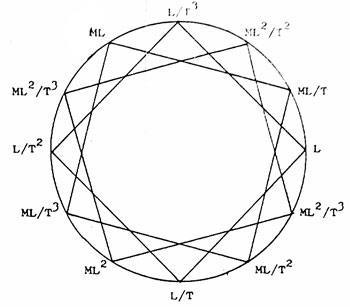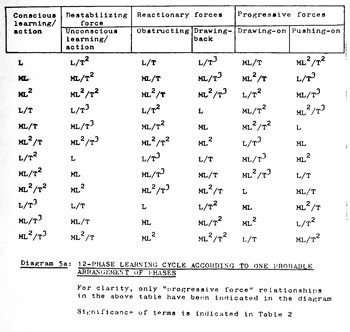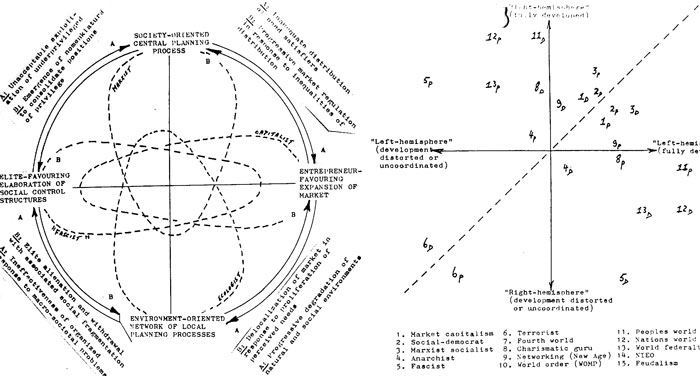The approach to learning discussed is too basic for it to be possible to derive much of significance that can be applied directly to organizations. The problem lies in the Western bias discussed earlier in favour of a learning "zigzag" in an essential linear direction. If the zigzag is considered as occuring around a learning cycle however, marrying in the Eastern bias towards recurrence, this cycle can then be subdivided into sufficiently detailed elements to be of significance for organizational operations. Jantsch discusses cyclical organization in terms of the system logic of dissipative self-organization:
"Hypercycles, which link autocatalytic units in cyclical organization, play an important role in many natural phenomena of self-organization, spanning a wide spectrum from chemical and biological evolution to ecological and economic systems and systems of population growth. The cyclical organization of a system may itself evolve if autocatalytic participants mutate or new processes become introduced. The co-evolution of participants in a hypercycle leads to the notion of an ultracycle which generally underlies every learning process." (21, p. 15)
The question then becomes how many discontinuous phases (Jantsch's "participants") it is useful to distinguish in the cycle. Too few and the incompatibilities between them are too fundamental, too many and the distinctions between them are too subtle. The operational significance of this conceptual constraint has been explored in earlier papers from which it is apparent that significance is lost if more than about 7 categories are used (43), unless the total breaks down into sub-sets based on simple (e.g. 2, 3, 5) factors (23).
A novel approach to the learning cycle in relation to action has been taken by Arthur Young (70) as a consequence of his experience as the inventor of the Bell helicopter (whose three-dimensional movement is notoriously difficult to control - as with the development process). He establishes the vital learning-action link through a new interpretation of the operational significance of the set of 12 "measure formulae" through which material phenomena are observed, acted upon and controlled in physics and engineering. Of special interest for the development theme is the significance he attaches to the sequence of movement around the cycle: one direction involving essentially unremernbered experience-without-learning, the other involving conscious learning-action. As briefly presented here (see Table 2 and Diagram 5), his approach has been adapted and modified to further emphasize the action-learning significance (#9). It is interesting that the philosopher Stephane Lupasco also attaches importance to the analysis of such measures in terms of the polarities they constitute and the types of energy with which they are associated (147, p. 26).
Inspection of this example clarifies how portions of such a cycle are vulnerable to institutionalization (as specialized, independent answer domains, or habitual responses) to the extent that there is no learning bridge across the discontinuities. The problem of (social) integration is thus intimately related to the functioning of (collective) learning cycles (#10). It seems probable that needs (and their satisfiers) also relate to different portions of such cycles, as would ranges of incompatible development goals or alternative visions of desirable futures. In each case the point to be emphasized is that such seemingly incompatible fragments are "frozen" portions of a cycle with which individuals or groups identify. None are of lasting significance in their own right, especially insofar as they hinder the collective learning process which must take place through them.
The facilitative and obstructive factors to further learning (i.e. successful "struggle" in marxist terms) at each stage in the cycle are probably linked to patterns of complementarity and incompatibility between the stages according to their membership of (2, 3, or 4-member) sub-sets in the cycle (e.g. preceding and succeeding stages in the cycle are in conflictual relationship since they would correspond to thinking of the opposite hemisphere). Answers given from any part of a cycle are of course "questionable" as perceived from other parts of the cycle.
| Time-binding learning Space-binding learning
| Unconscious
| Unconscious
| Homeostatic equilibrium
| Auto-catalytic response
| Uncoordinated action
| |
| Conscious
| Timeless awarence
| Conscious
| Comparison with:
| Comparison with previous comparisons
| ||
| (In- volution)
| (Re-volution)
|
| T°
| T-1
| T-2
| T-3
|
| Unintended shift of - perspective - position - reference Displacement of focus
| Intentional shift of - perspective - position - reference Range of conscious attention scan "Distance" from object of focus
| M°L Acts Abstract Schematic
| (l) Observation; act of considering; determin- ation of position reactive learning based
| (L/T) Adaptive change ; reaction; passive adaptation or change of position in response to changing circumstances
| (L/T2) Spontaneous
| (L/T3) Control of transformative action
|
| Unconscious impression of significance
| (See MLT°)
| ML States Informed Motivated Considered
| (ML) Recognition of moment (ousness), significance (as in "matters of great moment"), relevance (as related to leverage); weight of facts; importance; bringing matters into focus
| (ML/T) Recognition of the momentum (of an issue) resulting from a change, namely the consequential trans- formation of awareness or perspective
| (ML/T2) Forcefullness engendered, experienced or embodied as a result of transformative action; constructive (or disruptive) action potential; enhanced sense of being
| (ML/T3) Establishment of disciplined pattern of response; consolid- ated or harmonious control of action potential; holding forces in check
|
| Subjection to an unintended shift of perspective
| Projection of an intended shift of perspective into reality
| ML2 Relationships Application Follow-through Commitment Implementation
| (ML) Faith in current paradigm or perception of reality; unexarained, habitual commitment to a projection, proces, or understanding, irrespective of inconsistent disturbing factors
| (ML2/T) Decision or impulse to act or initiate a process determining the future
| (ML,2/T2) Achievement of a desired result by application of under- standing, and adjust- ment of implicit beliefs in response to external factors; working action on reality
| (ML2/T3) Power of acquired knowledge; know-how ; integrated or embodied experience; capacity (not to act) ; non- action
|
| Unexplained problems Imponderables External constraints
| Mass of inform- ation Amassed exper- ience Internal constraints Mass of evidence "Matter of fact"
| M
| Table 2: TENTATIVE CHARACTERISTICS OF PORTIONS OF A 12-PHASE LEARNI.NG CYCLE (see Diagram 5 ) (adapted and developed from Young (70))
| |||
 |  |
 |  |
As noted earlier, a single cycle is not a sufficiently concrete representation of the complexity to be encompassed by an adequate meta-answer. Where several cycles interlock to form a sphere, the nodes are effectively combinations of cyclic phases. The relationships of challenge and harmony between such nodes have been discussed in earlier papers (97, 98, 99) concerning Fuller's tensegrity concept (46).It is this which clarifies the potential and vulnerability of networking (1, 100) as an essentially right hemisphere mode of organization which needs to be more "seductively" married to the much-criticized left-hemisphere, hierarchical mode.
The acid test of learning cycles however, is whether they can encompass the discontinuities between the major political tendencies by which the world community is seemingly divided. Any such relationship posited must necessarily be highly controversial, but the controversy should be patterned according to the aspects of the learning challenges involved. As an exercise (in oversimplification) therefore, the 12-phase cycle has been collapsed to a 4-phase cycle, with portions of which the major political answer domains have been tentatively identified (see Diagram 6). Note that collapsing any cycle to this degree overloads each phase with significance so that any label effectively becomes a caricature of the multi-facetted reality associated with that phase.
Positions on each axis distant from the origin are here interpreted as indicating more extreme manifestations of the phase characteristics. The learning cycles within each phase are then effectively represented by distorted (elliptical) "cycles" in which other phases are "repressed" or "inadequately expressed". The range of elliptical shapes can be used to distinguish varieties of political tendencies sharing the same basic axis (#11). A somewhat related diagram (Diagram 7) can be used to highlight the problem of asymptotic convergence on a meta-answer. The axes represent right- and left-hemisphere thinking, with other equivalent dichotomies collapsed into them. The diagonal therefore reflects practical positions of balance between them, namely viable compromises between structure and process, for example (#12).
Some answer domains have tentatively been located on the necessarily oversimplified diagram in an approximate manner. A distinction is made between the answer as expressed in theory, doctrine, or public claims (subscript D), and the answer as it tends to manifest in practice (subscript P) faced with nasty decisions due to the consequences of its own limitations or impracticality. It would appear that the diagonal serves as a kind of "mirror" in that "D" answers are "rotated" about it into a corresponding "P" position when they are implemented and their negative features are experienced by others.
This would accord with the concept of the "repressed" or "inadequate" features of an answer being brought to light under such conditions. In Jungian terms, the "P" answer is the unconscious "shadow" (78, pp. 210-243) of the "D" answer. The "third perspective" is located on the diagonal, but the more ideal the practical combination of structure and process sought, the more "inaccessible" it is along the diagonal (#13).
 | |
| Indicating 4 phases characteristic of extreme policy options with the destabilizing dilemmas to which each is vulnerable The cycles associated with particular political strategies are indicated tentatively as "eliptically distorted" orbits with eccentricity and orientation according to the degree to which they embody the extreme policy phases. (Note the relationship to the constraints on movement of a steering "joy stick".) Larger orbits indicate strategies of greater scope which internalize a broader range of the lear ing processes to which society is subject. This approach could be used to distinguish between various "brands" of socialism, for example. Note that the shape of eccentric orbits could be used as an indicator of the relative amount of recognition accorded to corrective policies required at each stage in order to maintain a stable orbit. An orbital dynamics model also opens a new perspective on the problems of transitions between strategies. Orbital overlap could also be used to indicate the degree of shared strategic concern. | 1. Market capitalism 2. Social-democrat 3. Marxistsocialist 4.Anarchist 5. Fascist 6. Terrorist 7. Fourth world 8. Charismatic guru 9. Networking (New Age) 10. World order (WOMP) 11. Peoples world govt. 12. Nations world govt. 13. World federalism 14. NIEO 15. Feudalism |
| "Left-hemisphere" includes: hierarchical order, controlled participation, structure-oriented, form-oriented, efficiency/effectiveness, as well as dimensions associated with such symbols as yang, thanatos, and Apollonian. It also implies sufficient complexity to contain variety. "Right-hemisphere" includes: associative, participative, process-oriented, content-oriented, aesthetic, as well as dimensions associated with such symbols as yin, eros, and Dionysian. It also implies sufficient simplicity to be comprehensible readily as a gestalt. Note that percentions of positions after effective implementation in practice (subscript P) are displaced through the diagonal "mirror" from their positions as portrayed in theory or by advocate propaganda. | |
| Diagram 6: "Steering wheel" model of counter-flowing learning cycles | Diagram 7: Doctrine/Practice interrelationship of selected strategic options in terms of a 2-dimensional scheme of collapsed categories |